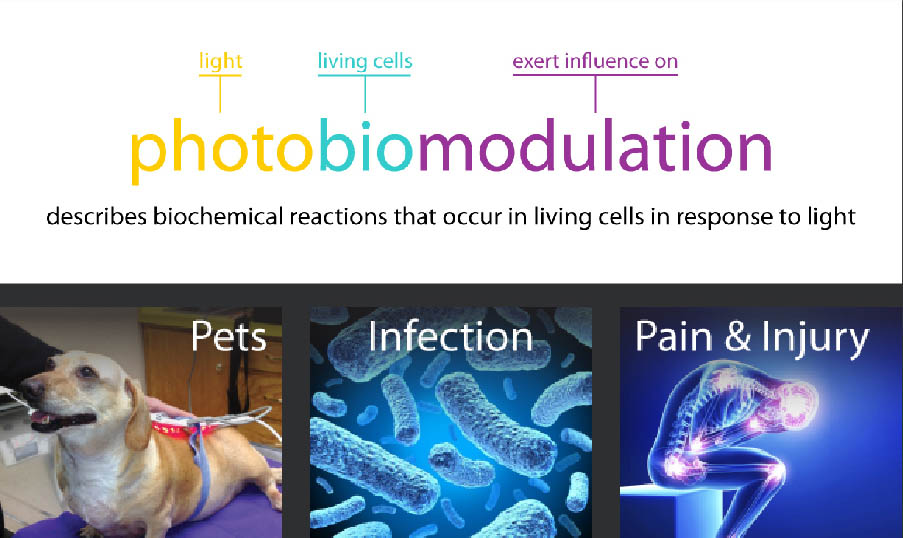What is Photobiomodulation?

Photobiomodulation (PBM) is a therapy based on specific wavelengths of light, usually red or near-infrared light, which is irradiated onto biological tissues to trigger intracellular photochemical reactions. In the field of pet health physical therapy, PBM has been proven to have significant potential in effectively alleviating chronic pain, regulating inflammation, promoting wound healing, repairing nerves, protecting joint and skin health, and enhancing overall immunity in pets. Vaymed will introduce the impact of PBM on pet health from the following aspects:
Alleviating Pain and Regulating Inflammation
PBM is widely recognized as a powerful remedy for chronic pain in pets, particularly exhibiting remarkable efficacy in alleviating pain caused by conditions such as arthritis. When administered at the correct dosage, Photobiomodulation (PBM) therapy decreases the mitochondrial membrane potential (MMP) in DRG neurons, which reduces ATP production and results in the conduction block of nociceptive nerves. The most direct effect of blocking nociceptors is pain relief.. At the same time, PBM plays a key role in regulating the inflammatory response in pets. In the face of inflammatory diseases such as allergic dermatitis and inflammatory bowel disease, PBM can accurately inhibit the release of inflammatory cytokines and reduce the infiltration of inflammatory cells, significantly alleviating inflammatory symptoms and relieving pets' discomfort. Numerous studies have shown that by inhibiting inflammatory cytokines such as TNF-α, IL-6, etc., PBM effectively reduces tissue damage in inflammatory diseases and protects the health of pets.
Promoting Wound Healing and Tissue Repair
For skin wounds in pets, whether they are post-surgical incisions or traumatic skin injuries, PBM accelerates the healing process. It promotes the formation of granulation tissue and angiogenesis, increasing the blood supply to the wound site and thus accelerating tissue repair. Studies have found that pets treated with PBM have significantly shorter wound healing times and achieve higher healing quality. PBM promotes the proliferation and migration of vascular endothelial cells and accelerates angiogenesis by activating the VEGFA/VEGFR2/STAT3 signaling pathway. PBM also plays an important role in the treatment of oral diseases, such as periodontitis or oral ulcers. It reduces inflammation and promotes tissue regeneration, leading to accelerated healing of oral ulcers and significant improvement in the health of periodontal tissues in pets treated with PBM.
Neuroprotection and Regeneration
PBM brings new hope to pets’ neurological injuries. Whether it is spinal cord injury or peripheral nerve injury, PBM can promote the metabolism and regeneration of nerve cells. Taking dogs with spinal cord injury as an example, PBM can stimulate the proliferation and differentiation of neural stem cells and promote the regeneration of nerve fibers, thus improving neurological function and enhancing the quality of life for pets. PBM uses the appropriate wavelengths to easily penetrate the area where the nerve endings are located and affect it. The cell bodies of the neurons are located within the dorsal nerve root ganglion, but the elongated cytoplasm (axon) of the neuron extends from the cell body to the bare nerve ending on the surface of the skin. The direct effects of photobiomodulation therapy are initially at the level of the epidermal nerve network, but the effects are transferred to the subcutaneous tissues, sympathetic ganglia, and neuromuscular junctions within muscles and nerve trunks.
Improving Joint Health & Enhancing Skin Health
For degenerative joint disease, which is common in elderly pets, PBM can slow the degeneration of joint cartilage and promote cartilage repair. Elderly dogs that receive regular PBM treatments experience significant improvements in joint mobility and flexibility, with a marked reduction in pain and stiffness. At the same time, PBM can also improve a pet's skin health by treating conditions such as skin allergies and folliculitis. By promoting skin cell renewal and repair, PBM helps restore the skin's barrier function and reduce symptoms like itching and redness, making your pet's skin healthier.
Enhancing Overall Immunity & Promoting Post-Operative Recovery
PBM can enhance the overall immunity of pets by regulating the balance of cytokines in their bodies and enhancing the function of immune cells. This is extremely important for the prevention and treatment of various infectious diseases. After a pet's surgical procedure, PBM can be used as an adjunctive treatment to accelerate the healing of surgical incisions, reduce post-operative pain and inflammation, and promote rapid recovery.
Indications for photobiomodulation:
Photobiomodulation is suitable for acute orthopedic conditions such as sprains, strains, post-surgical pain, contusions, back muscle pain, cervical or lumbar radicul.
References
[1] Photobiomodulation: Mechanisms and Applications in Dermatology - Jane Smith and Emily Johnson
[2] The Role of Photobiomodulation in Neurological Rehabilitation - Michael Brown and David Lee








